Using the Five Domains Model to Assess the Adverse Impacts of Husbandry, Veterinary, and Equitation Interventions on Horse Welfare
Abstract
:Simple Summary
Abstract
1. Introduction
2. Method
2.1. Panellist Recruitment and Selection
2.2. Pre-Workshop Survey
2.3. Workshop
- Assessment spreadsheets (those with laptops/tablets used these to enter their assessment scores; those without such technology used paper forms). The format of the assessments sheets’ spreadsheets was the same as the tables that appear in Supplementary Materials;
- The International Society for Equitation Science (ISES) position statement on aversive stimuli [26];
- The Five Domains poster [21]; and
2.4. Assumptions
2.5. Assessment of Adverse Welfare Impact
2.6. Statistical Analysis
- Y = Domain 5 score (0, 1, …, 9);
- θk = ordered intercept for Domain 5 score k;
- Scorei = effect Domain Score i (i = 1, …, 4), or pre-workshop score; and
- Participant = random effect of the participant.
3. Results
3.1. Descriptive Statistics
- C1 Weaning (Figure 2) (panellists n = 9)
- C2 Diet (Figure 3) (panellists n = 15)
- C3 Housing (Figure 4) (panellists n = 15)
- C4 Foundation Training (Figure 5) (panellists n = 7)
- C5 Ill-Health and Veterinary Interventions (chiefly medical) (Figure 6) (assessed by subpanel, panellists n = 4–5)
- C6 Ill-Health and Veterinary Interventions (chiefly surgical) (Figure 7) (assessed by subpanel, panellists n = 6–7)
- C7 Elective Procedures (Figure 8) (panellists n = 14–15)
- C8 Care Procedures (Figure 9) (panellists n = 14–15)
- C9 Restraint for Management Procedures (Figure 10) (panellists n = 14–15)
- C10 Road Transport (Figure 11) (panellists n = 7)
- C11 Activity—Competition (Figure 12) (panellists n = 7)
- C12 Activity—Work (Figure 13) (panellists n = 10)
- C13 Activity—Breeding Mares (Figure 14) (panellists n = 6)
- C14 Activity—Breeding Males (Figure 15) (panellists n = 5–6)
3.2. Associations with Domain 5
3.2.1. Pre-workshop vs. Domain 5
3.2.2. Domains 1 to 4 vs. Domain 5
4. Discussions
4.1. Adverse Effects and HBA
4.2. Comments on Specific Interventions
4.3. Potential Research Gaps
4.4. Pre-Workshop and Post-Workshop Impact Scores
4.5. Limitations of the Current Framework
4.6. Recommendations
5. Conclusions
Supplementary Materials
Acknowledgments
Author Contributions
Conflicts of Interest
Appendix A.
| Context | Intervention Deleted | Reason |
|---|---|---|
| Housing | Indoor stable—No social contact with turn-out to paddock | Deleted due to lack of time |
| Indoor stable—Partial social contact with turn-out to paddock | ||
| Indoor stable—Full social contact with turn-out to paddock | ||
| Surgical | Surgical deep intra-cavity surgery (e.g., synovial sepsis, sinusitis) | >Lack of time |
| Elective procedures | Measuring | Considered likely to be of negligible impact |
| Weighing | ||
| Docking | Banned in most jurisdictions | |
| Care procedures | Hogging | Lack of time or considered likely to be of negligible impact |
| Trim outside edge and/or inside ears | ||
| Apply make-up to eyes, muzzle | ||
| Apply earplugs | ||
| Apply nostril applications to change smells | ||
| Mascara on eyelashes | ||
| Hosing down | ||
| Sponging and ice buckets | ||
| Overnight treatments (e.g., ice bandages etc.) | ||
| Braiding | ||
| Mane hogging | ||
| Scissors to tidy the dock/thin the mane | ||
| Trimming tails short (level with hocks) | ||
| Fitting false plaits to manes and tails | ||
| Washing with non-animal products (e.g., bleach, laundry whitener) | ||
| Use of different types of brushes | ||
| Wiping eyes and nostrils with a cloth and dock | ||
| Coat techniques (e.g., quarter marks, sharks teeth) | ||
| Clipping | ||
| Trim chestnuts | ||
| Coat cleaning/de-tangling products | ||
| Bot fly knife use | ||
| Stable bandages to prevent leg-filling/keep clean | ||
| Use of other boots in stables (e.g., hocks, sausage boot) | ||
| Care of wet, hairy horses after riding | ||
| Cleaning out hooves | ||
| Hoof-shaping for performance traits (e.g., extra-long toes) | ||
| Shoeing—performance purpose (e.g., weighted hackneys) | ||
| Trim coronet band | ||
| Cut off feathers | ||
| Sandpapering hooves | ||
| Application of tail raisers and/or irritants to raise the tail | Banned in most jurisdictions | |
| Performance enhancing irritants (e.g., WD-40 on coronets) | ||
| Restraint | Gag | Too broad |
| Hobbles | ||
| Fencing | ||
| Activity—competition | Showing—training | Lack of time and no benefit in differentiating between training and competition (training considered as part of competition) |
| Eventing—training | ||
| Dressage—training | ||
| Endurance—training | ||
| Trail riding—training | ||
| Western performance (reining)—training | ||
| Pony club—training | ||
| Adult riding club—training | ||
| Driving (Carriage)—training | ||
| Driving (Carriage)—competition | ||
| Flat racing—training | ||
| Jumps racing—training | ||
| Harness racing—training | ||
| Polo—training | ||
| Activity—work | Horses in research | Too broad |
| Activity—breeding females | Donor mare for oocyte transfer/embryo transfer | Lack of time |
| Recipient mare for oocyte transfer/embryo |
| Context | Original Intervention | Modified Intervention |
|---|---|---|
| Diet | Pasture | Pasture—no choice |
| Pasture—choice | ||
| Foundation training | Bit habituation | Bit habituation with reins |
| Backing | Backing (<18 months) | |
| Backing (>18 months) | ||
| Side-reining | Side-reining (forced flexion) | |
| Medical | Medical—immediately curative (e.g., medical colic) | Medical—one-off, immediately curative (e.g., spasmodic colic) |
| Medical—short-term curative (e.g., sweet itch, uveitis, lameness, kick injury to limb) | Medical—repeated, short-term curative (e.g., fresh superficial mid-cannon injury to a forelimb) | |
| Medical—long-term curative (e.g., equine gastric ulcer syndrome, equine herpes virus, equine influenza, colitis, diarrhoea, hyperlipaemia, minor tendon injuries, weight loss, laminitis) | Medical—repeated, long-term curative (e.g., equine gastric ulcer syndrome, equine herpes virus, equine influenza, colitis, diarrhoea, hyperlipaemia, minor tendon injuries, weight loss, laminitis) | |
| Medical—prolonged palliative treatment (e.g., chronic obstructive pulmonary disease (recurrent airway obstruction) | Medical—prolonged palliative treatment (e.g., sweet itch/Queensland itch, chronic obstructive pulmonary disease (recurrent airway obstruction) | |
| Surgical | Surgical single curative intra-cavity surgery or repeated minor surgery (e.g., cryptorchid, osteochondrosis dissecans lesions, osteochondrosis, developmental osteochondral fragments) | Surgical single curative intra-cavity surgery or repeated minor surgery (e.g., inguinal cryptorchid, osteochondrosis dissecans lesions (osteochondrosis,) |
| - | Surgical major deep intra-cavity surgery (e.g., colic—surgical torsion) | Surgical major deep intra-cavity surgery (e.g., colic—surgical torsion—small intestine resection, developmental osteochondral fragment removal) |
| Weaning | Weaning with unrelated adults | Weaning with unrelated adults (mares being removed at intervals from an established group of mares and foals) |
| Care procedures | Neck rug | Rugging |
| Hoods | Hoods (applying) | |
| Collars for windsuckers/crib-biters (or other devices for behaviour modifications) | Collars for windsuckers/crib-biters | |
| Trimming | Trimming hooves | |
| Shoeing—general | Shoeing—cold | |
| Shoeing—hot | ||
| Deworming | ||
| Restraint | Headcollar, bridle, bit (of varying levels of severity) | Chifney |
| Chain on gums | ||
| Road transport | Group—with familiar companions | Group—with familiar companions—individually penned |
| Group—with unfamiliar companions | Group—with unfamiliar companions—individually penned | |
| Group—with familiar companions, penned as a group | ||
| Activity—competition | Showing—competition | Showing—in-hand |
| Showing—ridden | ||
| Pony club—competition | Community club—competition | |
| Adult riding club—competition | ||
| Show jumping | ||
| Polo/polocrosse | Polo | |
| Activity—work | Riding school | Riding school/riding for the disabled/therapeutic riding horse |
| Riding for the disabled | ||
| Therapeutic riding horse | ||
| Rental stables | ||
| Activity—breeding females | - | Brood mare—pasture matings |
| Brood mare—in-hand matings | ||
| Brood mare—artificial insemination | ||
| Activity—breeding males | Breeding stallion—in-hand matings (including semen collection) | Breeding stallion—in-hand matings |
| Breeding stallion—artificial insemination |
References
- Home Office. Guidance on the Operation of the Animals (Scientific Procedures Act 1986); HMSO: London, UK, 1986.
- Perel, P.; Roberts, I.; Sena, E.; Wheble, P.; Briscoe, C.; Sandercock, P.; Macleod, M.; Mignini, L.E.; Jayaram, P.; Khan, K.S. Comparison of treatment effects between animal experiments and clinical trials: Systematic review. BMJ 2007, 334, 197. [Google Scholar] [CrossRef] [PubMed]
- Mason, G.; Mendl, M. Why is there no simple way of measuring animal welfare? Anim. Welf. 1993, 2, 301–319. [Google Scholar]
- Bracke, M.B.M.; Spruijt, B.; Metz, J. Overall animal welfare assessment reviewed. Part 1: Is it possible? Neth. J. Agric. Sci. 1999, 47, 279–291. [Google Scholar]
- Dawkins, M.S. Using behaviour to assess animal welfare. Anim. Welf. 2004, 13, 3–7. [Google Scholar]
- Hemsworth, P.H.; Coleman, G.J. Human-Livestock Interactions: The Stockperson and the Productivity and Welfare of Farmed Animals, 2nd ed.; CAB International: Oxon, UK, 2011. [Google Scholar]
- Bracke, M.B.M.; Spruijt, B.M.; Metz, J.H.M.; Schouten, W.G.P. Decision support system for overall welfare assessment in pregnant sows A: Model structure and weighting procedure. J. Anim. Sci. 2002, 80, 1819–1834. [Google Scholar] [CrossRef] [PubMed]
- Barnard, C. Ethical regulation and animal science: Why animal behaviour is special. Anim. Behav. 2007, 74, 5–13. [Google Scholar] [CrossRef]
- Nicol, C.J.; Caplen, G.; Edgar, J.; Browne, W.J. Associations between welfare indicators and environmental choice in laying hens. Anim. Behav. 2009, 78, 413–424. [Google Scholar] [CrossRef]
- Bracke, M.B.M.; Metz, J.H.M.; Spruijt, B.M.; Schouten, W.G.P. Decision support system for overall welfare assessment in pregnant sows B: Validation by expert opinion. J. Anim. Sci. 2002, 80, 1835–1845. [Google Scholar] [CrossRef] [PubMed]
- Spoolder, H.; De Rosa, G.; Horning, B.; Waiblinger, S.; Wemelsfelder, F. Integrating parameters to assess on-farm welfare. Anim. Welf. 2003, 12, 529–534. [Google Scholar]
- Haslam, S.M.; Kestin, S.C. Use of conjoint analysis to weight welfare assessment measures for broiler chickens in UK husbandry systems. Anim. Welf. 2003, 12, 669–675. [Google Scholar]
- Whay, H.R.; Main, D.C.J.; Green, L.E.; Webster, A.J.F. Animal-based measures for the assessment of welfare state of dairy cattle, pigs and laying hens: Consensus of expert opinion. Anim. Welf. 2003, 12, 205–217. [Google Scholar]
- Rousing, T.; Jakobsen, I.A.; Hindhede, J.; Klaas, I.C.; Bonde, M.; Rensen, J.T. Evaluation of a welfare indicator protocol for assessing animal welfare in AMS herds: Researcher, production advisor and veterinary practitioner opinion. Anim. Welf. 2007, 16, 213–216. [Google Scholar]
- Broom, D.M. Quality of life means welfare: How is it related to other concepts and assessed? Anim. Welf. 2007, 16, 45–53. [Google Scholar]
- Kirkwood, J.K. Quality of life: The heart of the matter. Anim. Welf. 2007, 16, 3–7. [Google Scholar] [CrossRef]
- Scott, E.M.; Nolan, A.M.; Reid, J.; Wiseman-Orr, M.L. Can we really measure animal quality of life? Methodologies for measuring quality of life in people and other animals. Anim. Welf. 2007, 16, 17–24. [Google Scholar]
- Yeates, J.W. Is ‘a life worth living’ a concept worth having? Anim. Welf. 2011, 20, 397–406. [Google Scholar]
- Mellor, D.J.; Beausoleil, N.J. Extending the ‘Five Domains’ model for animal welfare assessment to incorporate positive welfare states. Anim. Welf. 2015, 24, 241–253. [Google Scholar] [CrossRef]
- Mellor, D.J.; Reid, C.S.W. Concepts of animal well-being and predicting the impact of procedures on experimental animals. In Improving the Well-Being of Animals in the Research Environment; Baker, R., Jenkin, G., Mellor, D.J., Eds.; Australian and New Zealand Council for the Care of Animals in Research and Teaching: Glen Osmond, Australia, 1994; pp. 3–18. [Google Scholar]
- Beausoleil, N.J.; Mellor, D.J. Advantages and limitations of the Five Domains model for assessing welfare impacts associated with vertebrate pest control. N. Z. Vet. J. 2015, 63, 37–43. [Google Scholar] [CrossRef] [PubMed]
- Williams, V.M.; Mellor, D.J.; Marbrook, J. Revision of a scale for assessing the severity of live animal manipulations. Altern. Anim. Exp. ALTEX 2006, 23, 163–169. [Google Scholar]
- Mellor, D.J.; Patterson-Kane, E.; Stafford, K.J. The Sciences of Animal Welfare; Wiley-Blackwell Publishing: Oxford, UK, 2009. [Google Scholar]
- Sharp, T.; Saunders, G. A Model for Assessing the Relative Humaneness of Pest Animal Control Methods, 1st ed.; Australian Government Department of Agriculture, Fisheries and Forestry: Canberra, Australia, 2008.
- Beausoleil, N.J.; Fisher, P.; Littin, K.E.; Warburton, B.; Mellor, D.J.; Dalefield, R.R.; Cowan, P. A systematic approach to evaluating and ranking the relative animal welfare impacts of wildlife control methods: Poisons used for lethal control of brushtail possums (Trichosurus vulpecula) in New Zealand. Wildl. Res. 2016, 43, 553–565. [Google Scholar] [CrossRef]
- International Society for Equitation Science. The Use of Aversive Stimuli in Horse Training. 2013. Available online: http://equitationscience.com/equitation/position-statement-on-aversive-stimuli-in-horse-training (accessed on 22 December 2017).
- Huntingdon, P.; Myers, J.; Owens, J. Horse Sense: The Guide to Horse Care in Australia and New Zealand, 2nd ed.; Landlinks Press: Collingwood, Australia, 2004. [Google Scholar]
- Munroe, G.; Weese, S. Equine Clinical Medicine: Surgery and Reproduction; CRC Press: Boca Raton, FL, USA, 2011. [Google Scholar]
- Sharp, T.; Saunders, G. A Model for Assessing the Relative Humaneness of Pest Animal Control Methods, 2nd ed.; Australian Government Department of Agriculture, Fisheries and Forestry: Canberra, Australia, 2011.
- Jones, B.; McGreevy, P.D. Ethical equitation: Applying a cost-benefit approach. J. Vet. Behav. 2010, 5, 196–202. [Google Scholar] [CrossRef]
- Mellor, D.J. Operational details of the Five Domains Model and its key applications to the assessment and management of animal welfare. Animals 2017, 7, 60. [Google Scholar] [CrossRef] [PubMed]
- Agresti, A. Categorical Data Analysis; John Wiley & Sons: New York, NY, USA, 2002. [Google Scholar]
- Christensen, R.H.B. Regression Models for Ordinal Data. R Package Version. Available online: http://www.cran.r-project.org/ (accessed on 18 March 2018).
- Schwartzkpof-Genswein, K.S.; Stookey, J.M. The use of infrared thermography to assess inflammation associated with hot-iron and freeze branding in cattle. Can. J. Anim. Sci. 1997, 77, 577–583. [Google Scholar] [CrossRef]
- Cooper, J.; McGreevy, P.D. Stereotypic behaviour in the stabled horse: Causes, effects and prevention without compromising horse welfare. In The Welfare of Horses; Waran, N., Ed.; Springer: Berlin, Germany, 2007; pp. 99–124. [Google Scholar]
- Nicol, C.J.; Badnell-Waters, A.J.; Bice, R.; Kelland, A.; Wilson, A.D.; Harris, P.A. The effects of diet and weaning method on the behaviour of young horses. Appl. Anim. Behav. Sci. 2005, 95, 205–221. [Google Scholar] [CrossRef]
- Fenner, K.; Yoon, S.; White, P.; Starling, M.J.; McGreevy, P.D. The effect of noseband tightening on horses’ behavior, eye temperature, and cardiac responses. PLoS ONE 2016, 11, e0154179. [Google Scholar] [CrossRef] [PubMed]
- Duquesne, F.; Pronost, S.; Laugier, C.; Petry, S. Identification of Taylorella equigenitalis responsible for contagious equine metritis in equine genital swabs by direct polymerase chain reaction. Res. Vet. Sci. 2007, 82, 47–49. [Google Scholar] [CrossRef] [PubMed]
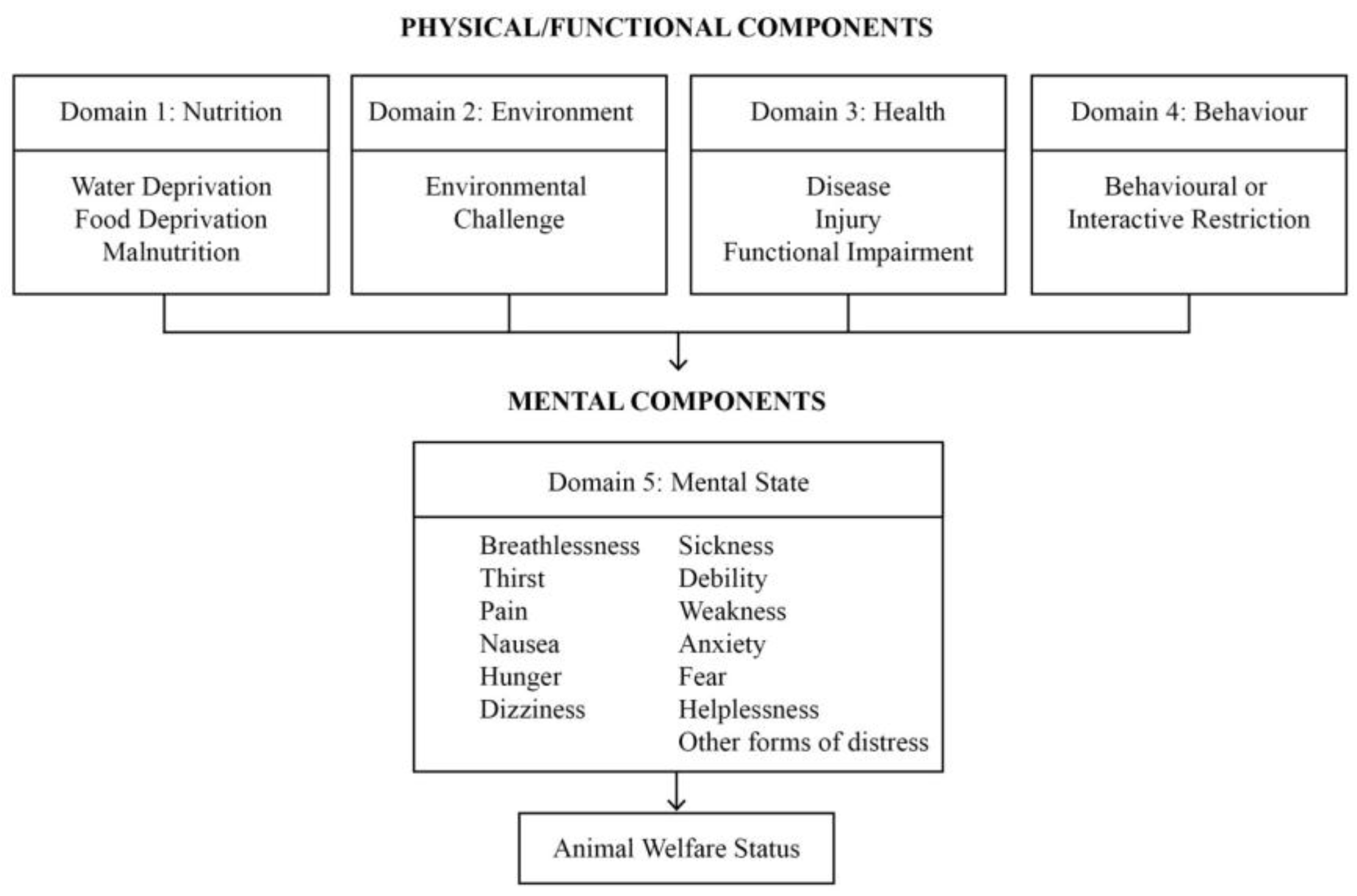
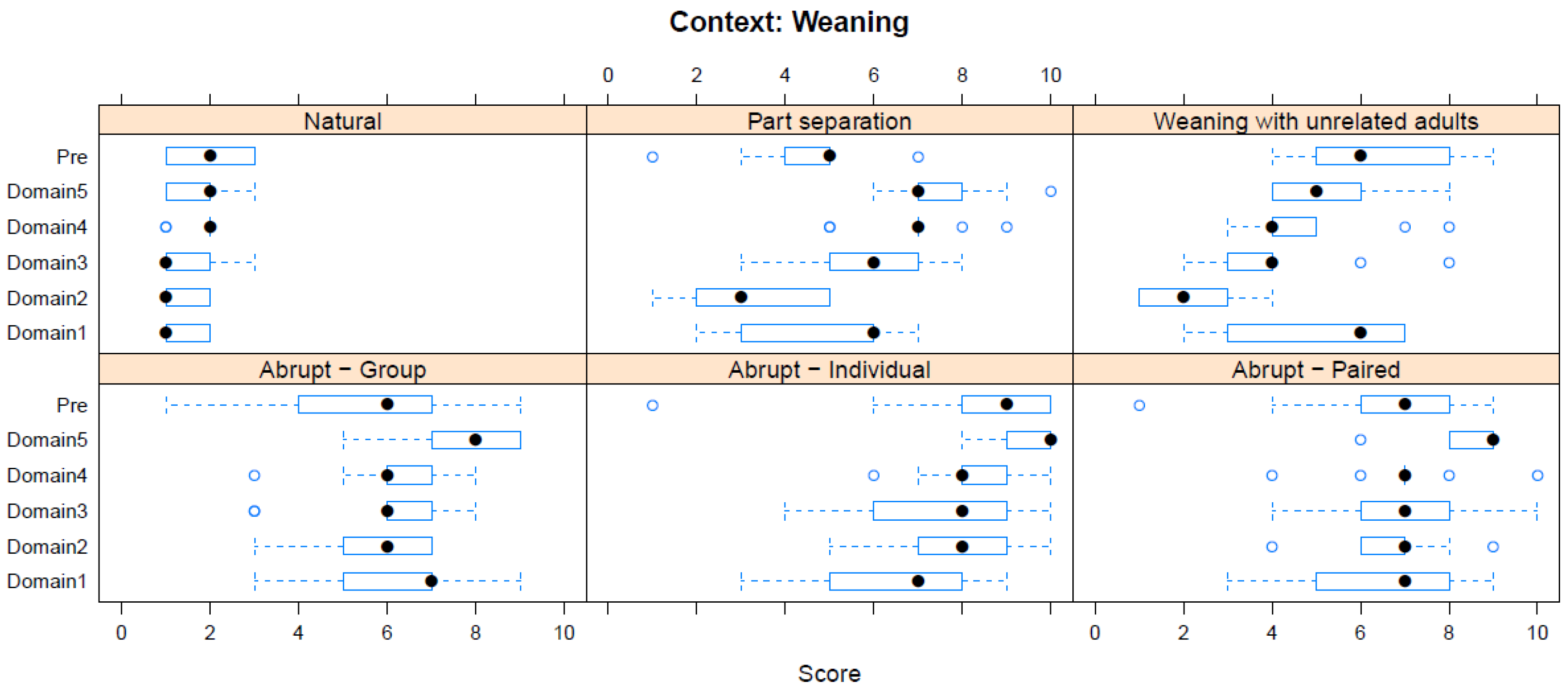
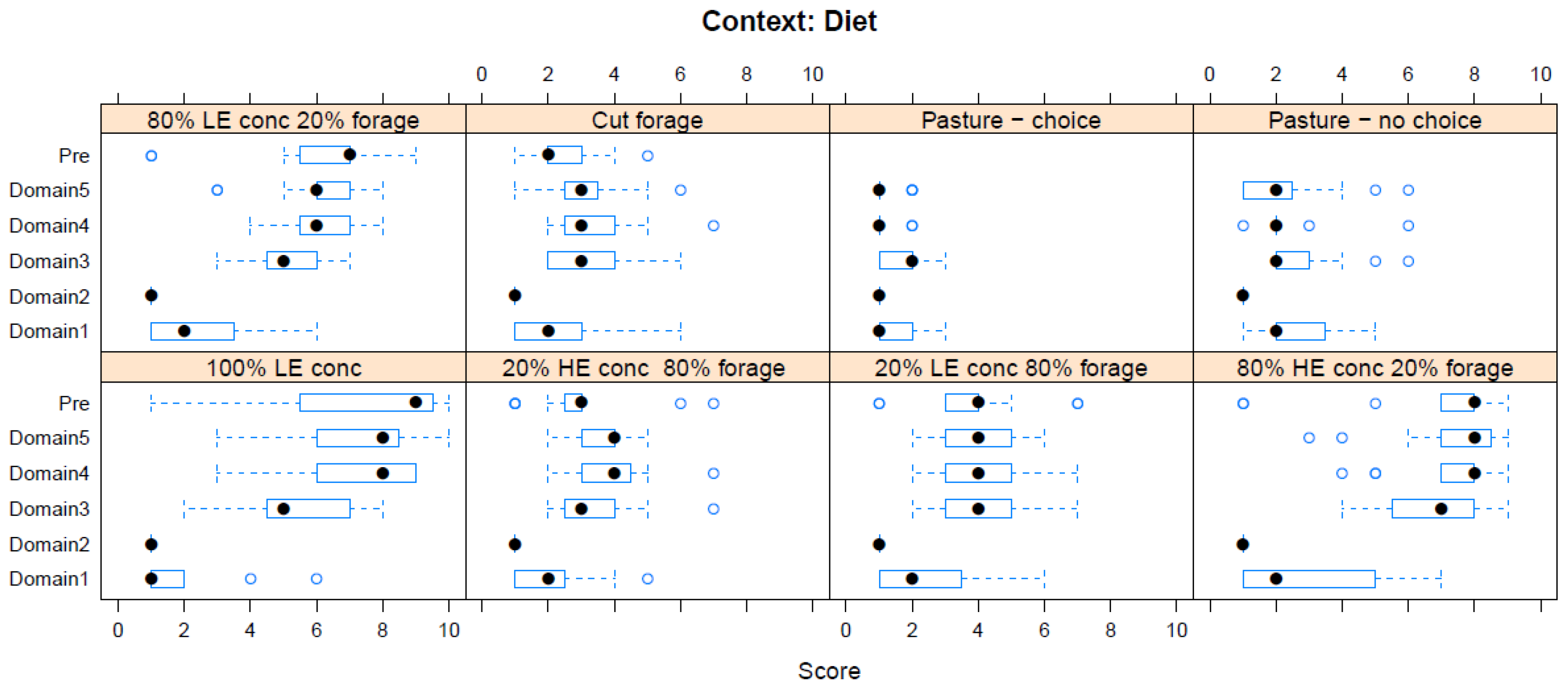
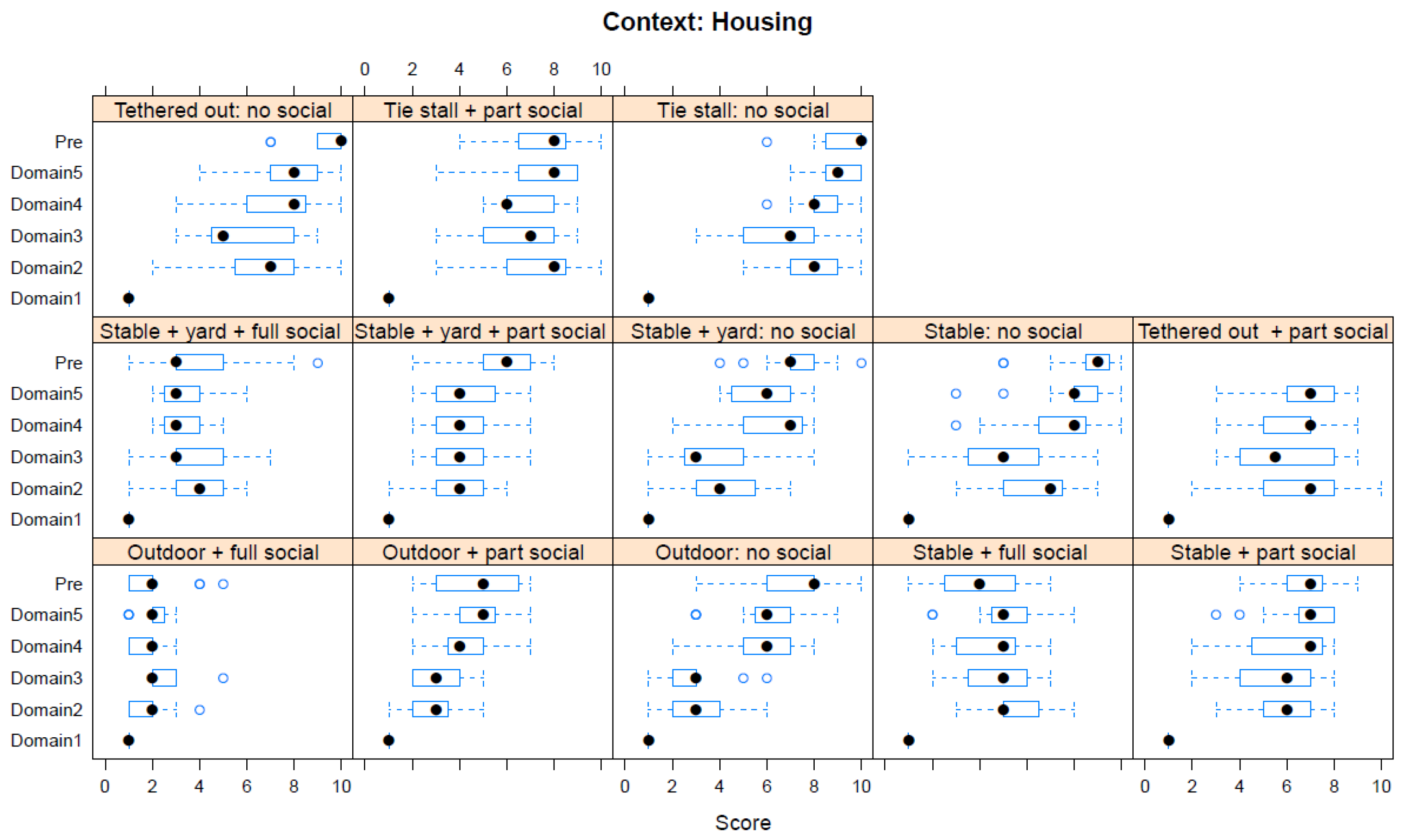



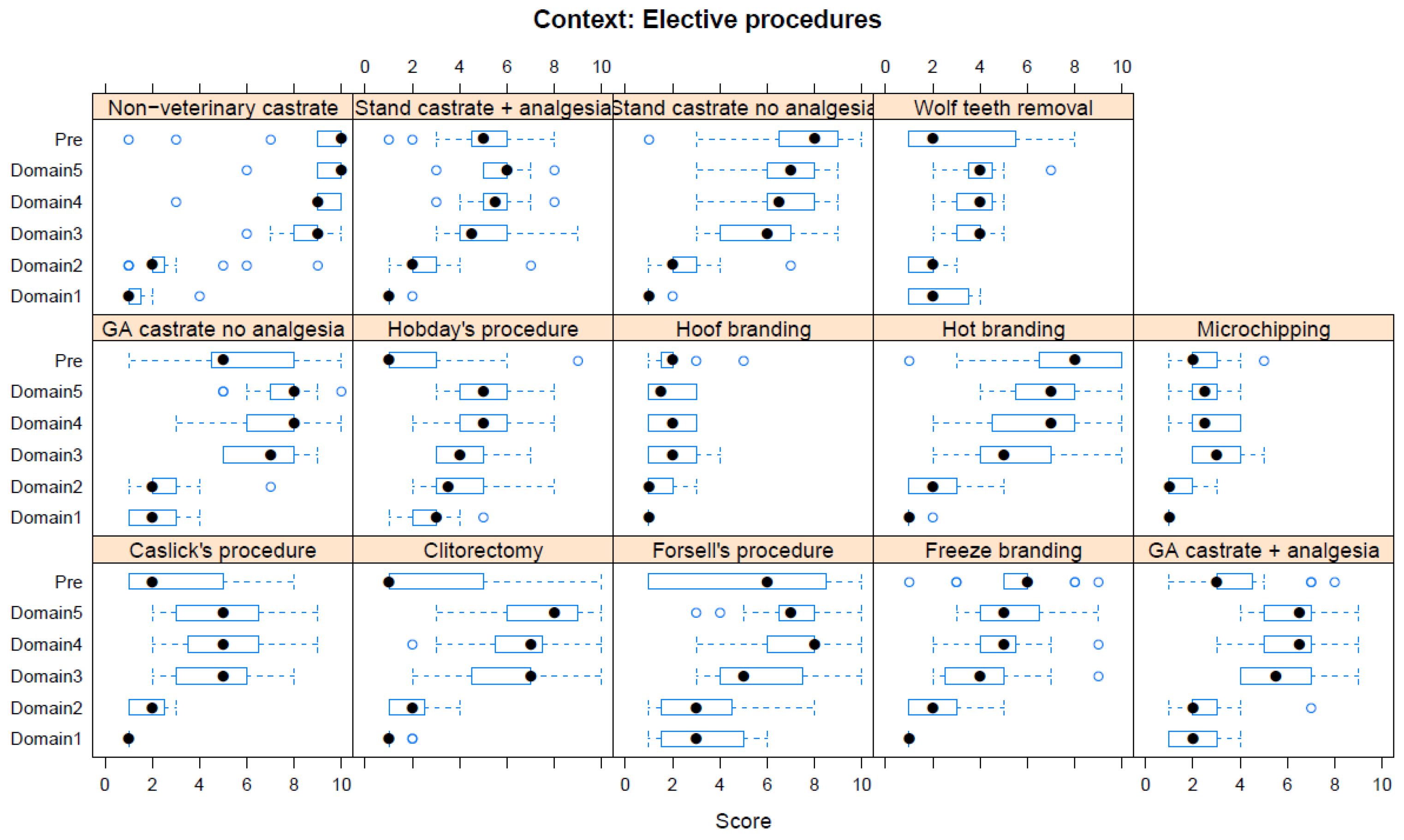

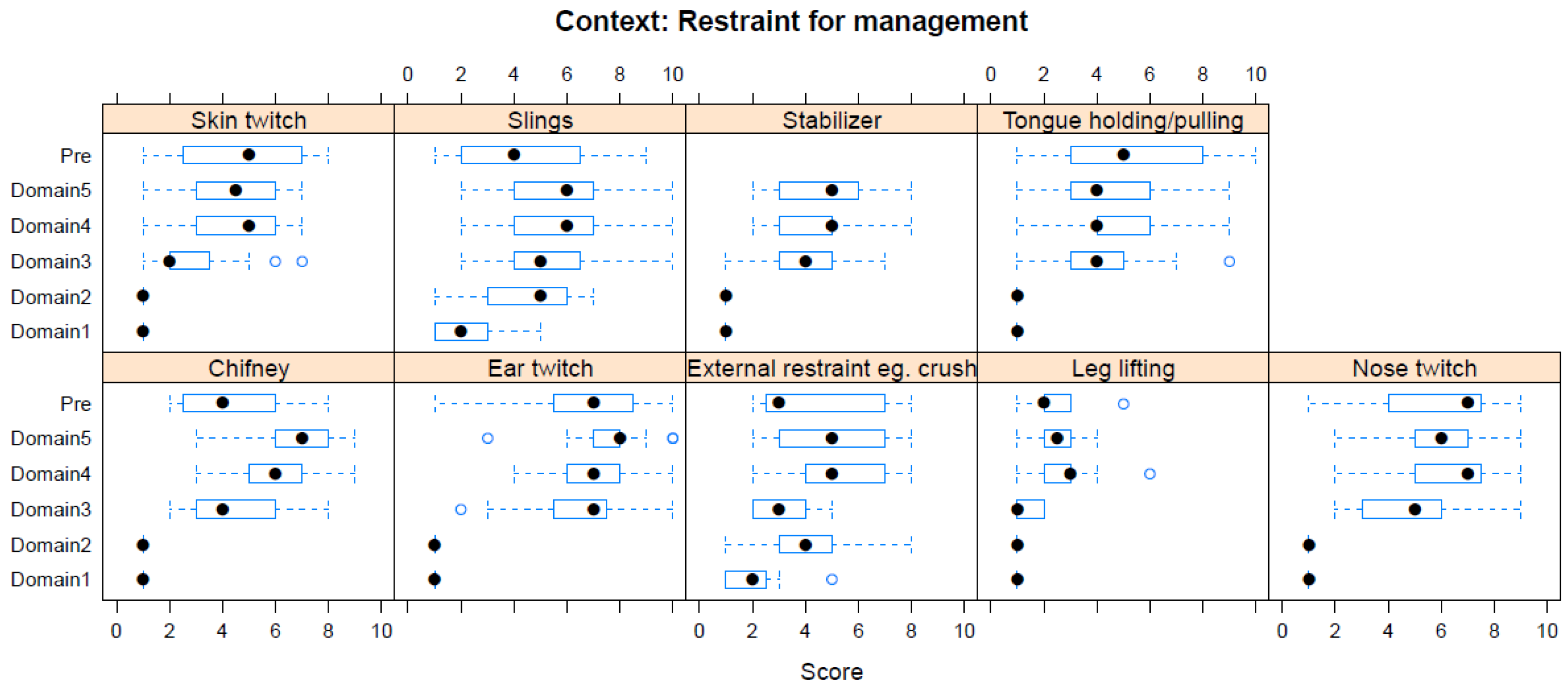
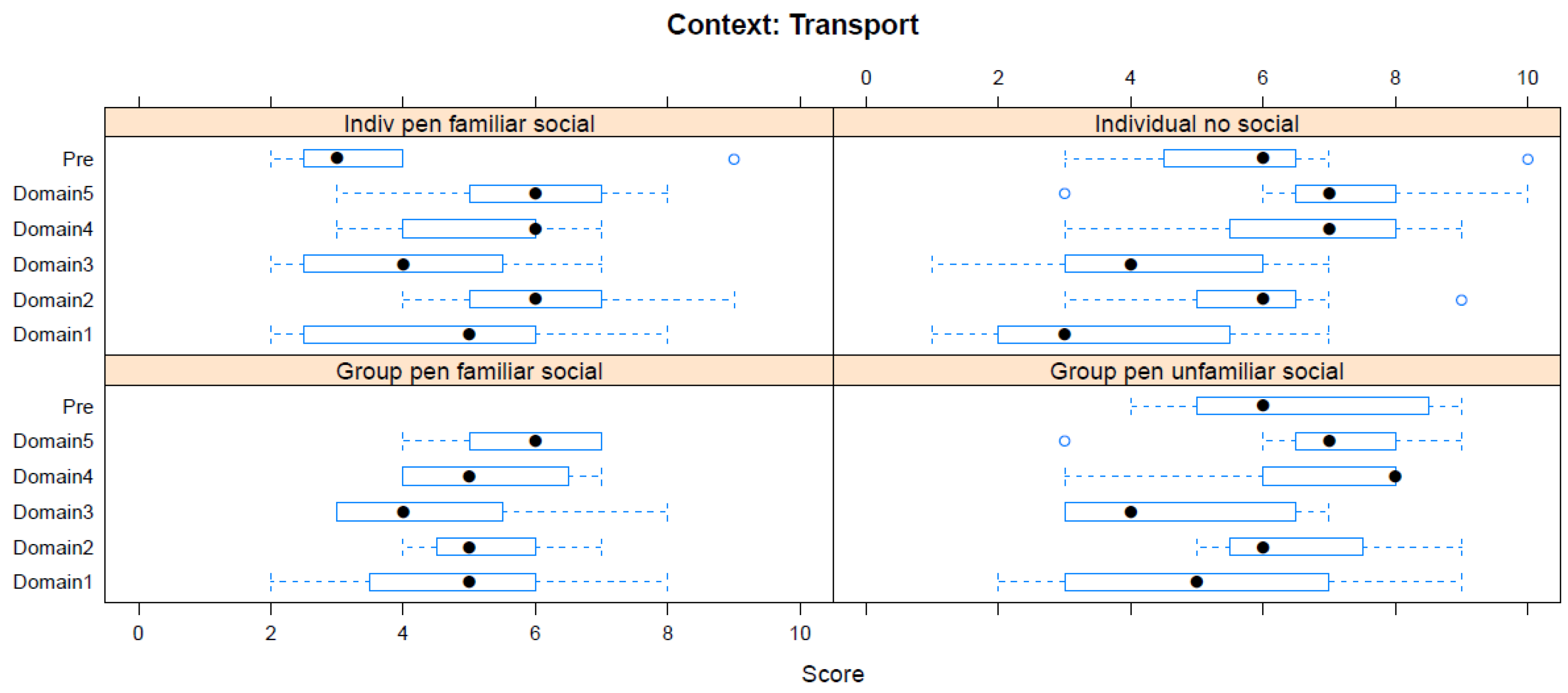
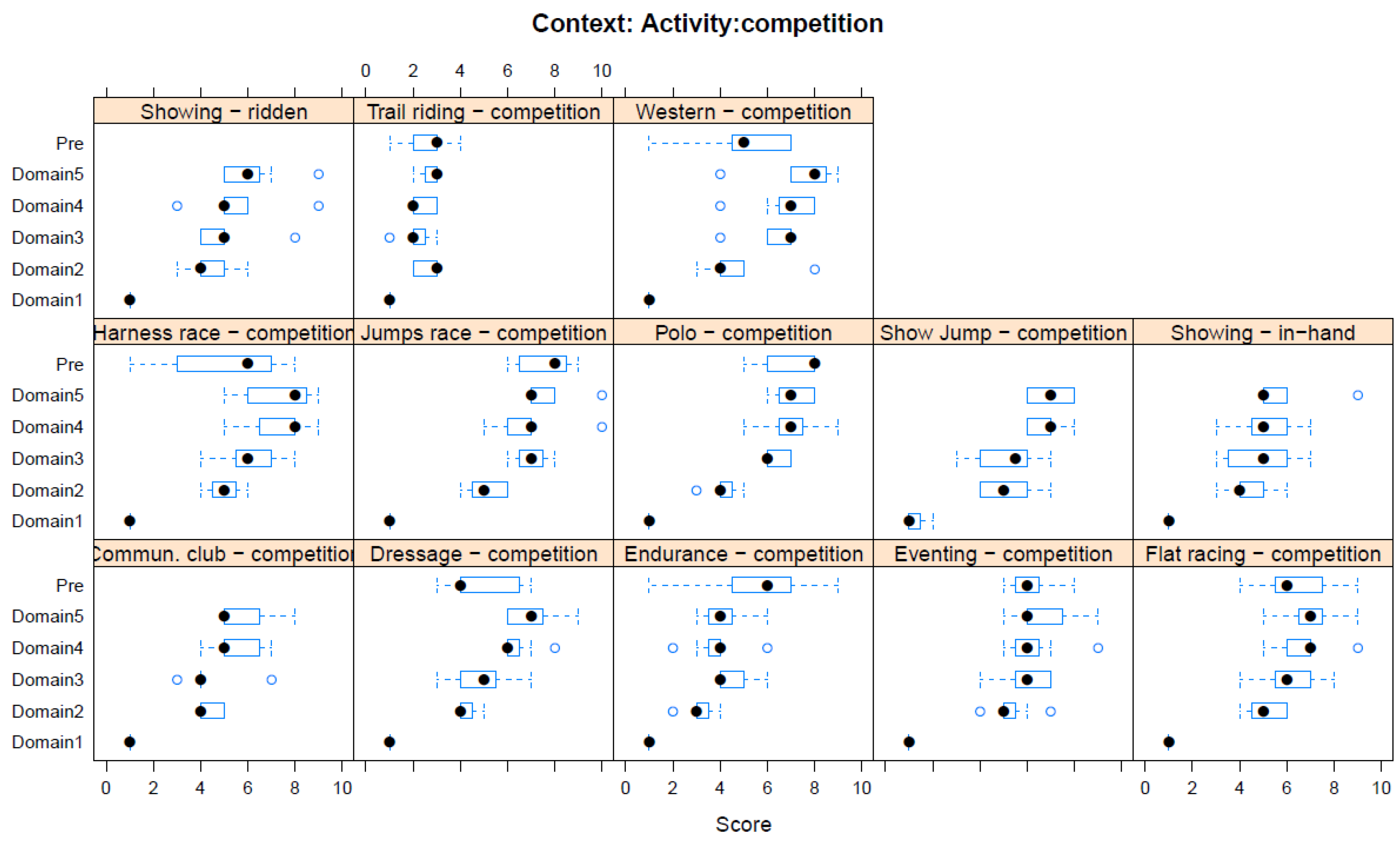
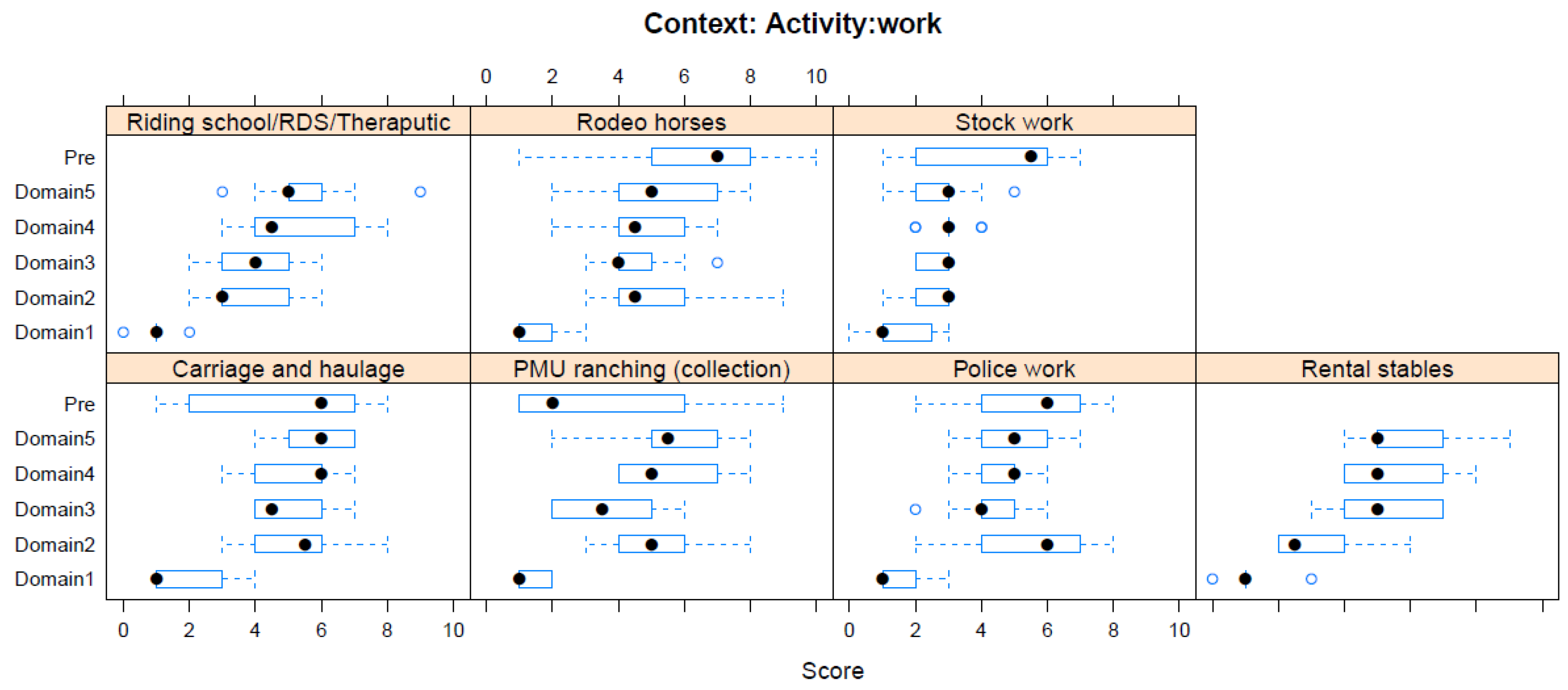

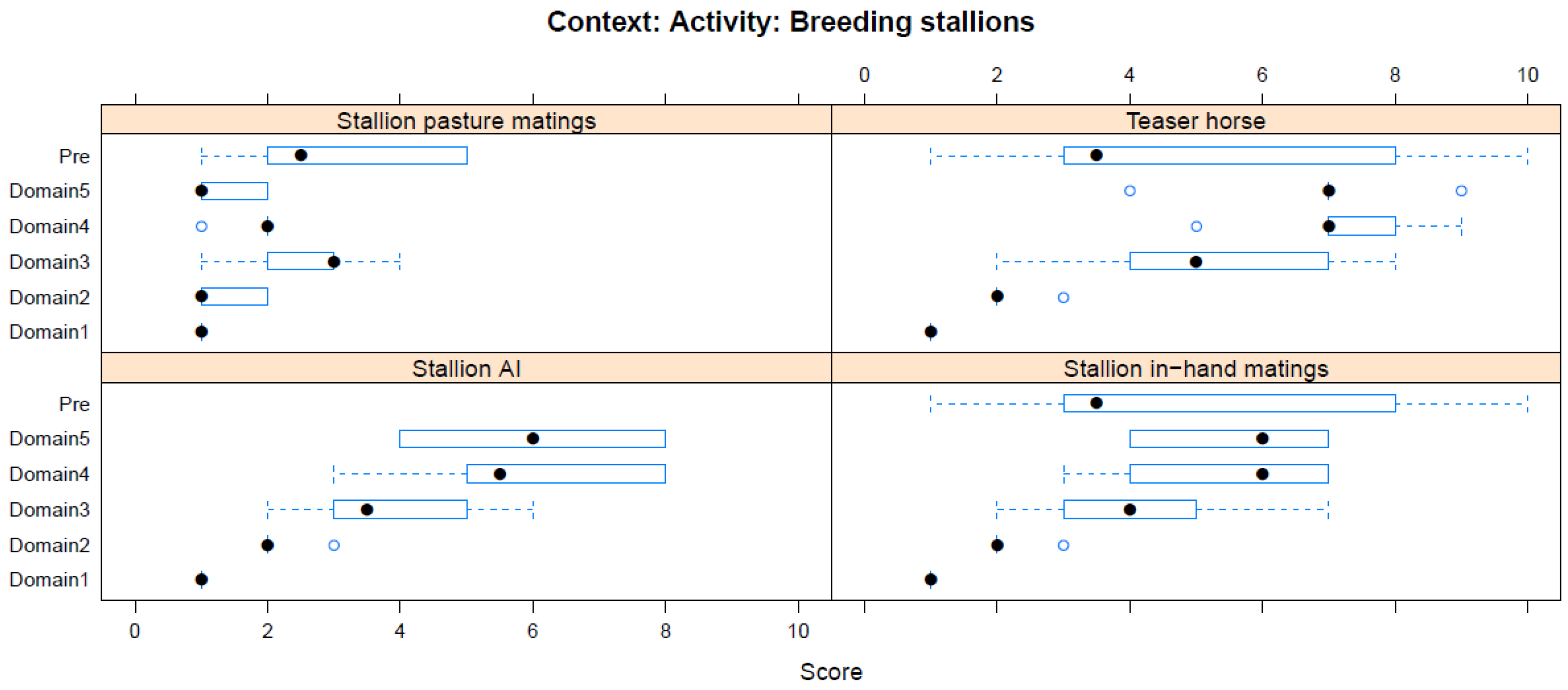


| Context | Domain 1 | Domain 2 | Domain 3 | Domain 4 | Pre WS |
|---|---|---|---|---|---|
| Weaning | 5.4×10–9 | 1.7×10–8 | 8.8×10–14 | <2.2×10–16 | 7.2×10–6 |
| Diet | 0.11 | * | <2.2×10–16 | <2.2×10–16 | 1.6×10–13 |
| Housing | * | <2.2×10–16 | <2.2×10–16 | <2.2×10–16 | <2.2×10–16 |
| Foundation training | * | 0.0053 | <2.2×10–16 | <2.2×10–16 | 8.6×10–5 |
| Medical interventions | 0.011 | 0.18 | 1.3×10–6 | 7.6×10–5 | 0.073 |
| Surgical interventions | 0.00018 | 0.031 | 0.00095 | 5.6×10–09 | 0.14 |
| Elective procedures | 0.24 | 0.00081 | <2.2×10–16 | <2.2×10–16 | <2.2×10–16 |
| Care procedures | 1.8×10–7 | 0.0041 | <2.2×10–16 | <2.2×10–16 | <2.2×10–16 |
| Restraint for management | 0.50 | 0.63 | <2.2×10–16 | <2.2×10–16 | 0.00025 |
| Transport | 0.51 | 0.013 | 0.22 | 5.0×10–8 | 3.7×10–5 |
| Activity: competition | 0.82 | 8.9×10–13 | <2.2×10–16 | <2.2×10–16 | 0.0030 |
| Activity: work | 0.61 | 6.5×10–7 | 1.2×10–6 | <2.2×10–16 | 0.028 |
| Activity: breeding mares | 0.00052 | 2.4×10–7 | 0.025 | 7.5×10–11 | 0.73 |
| Activity: breeding stallions | * | 0.0038 | 0.00059 | 4.1×10–11 | 0.00068 |
| Weaning | Diet | Housing | Foundation training | Medical | Surgical | Elective Procedures | ||||||||
| Pre-workshop | ||||||||||||||
| Score | Estimate | Std. Error | Estimate | Std. Error | Estimate | Std. Error | Estimate | Std. Error | Estimate | Std. Error | Estimate | Std. Error | Estimate | Std. Error |
| 1 | 0.00 | 0.00 | 0.00 | 0.00 | 0.00 | |||||||||
| 2 | −1.62 | 1.30 | −3.77 | 1.26 | 2.97 | 1.05 | 2.84 | 1.26 | 0.00 | 0.00 | −4.20 | 0.60 | ||
| 3 | −0.79 | 1.26 | −2.54 | 1.12 | 3.22 | 1.05 | 3.64 | 1.48 | −0.88 | NA | 2.66 | 2.18 | −1.18 | 0.58 |
| 4 | 0.27 | 1.11 | −1.00 | 1.13 | 4.08 | 1.05 | 5.31 | 1.69 | −2.30 | NA | 0.00 | 2.23 | −0.92 | 0.66 |
| 5 | 1.37 | 1.14 | 0.43 | 1.18 | 4.05 | 1.05 | 5.03 | 1.51 | 4.49 | 2.31 | −0.95 | 0.50 | ||
| 6 | 2.28 | 1.15 | −0.27 | 1.34 | 5.13 | 1.07 | 4.60 | 1.45 | −2.67 | NA | 3.46 | 2.12 | −1.00 | 0.52 |
| 7 | 3.35 | 1.30 | 1.43 | 1.08 | 6.13 | 1.05 | 6.65 | 1.75 | 2.12 | NA | 1.28 | 2.90 | 0.39 | 0.64 |
| 8 | 2.89 | 1.18 | 3.02 | 1.15 | 6.97 | 1.08 | 6.83 | 1.89 | 5.88 | 2.47 | 0.72 | 0.54 | ||
| 9 | 3.35 | 1.43 | 4.57 | 1.34 | 8.32 | 1.11 | 6.79 | 2.39 | 5.11 | 2.34 | 1.74 | 0.63 | ||
| 10 | 6.38 | 1.73 | 4.45 | 1.44 | 9.42 | 1.13 | 7.16 | 2.01 | 5.66 | 2.57 | 3.98 | 0.62 | ||
| Care Procedures | Restraint | Transport | Competition | Work | Breeding Females | Breeding Males | ||||||||
| Pre-workshop | ||||||||||||||
| Score | Estimate | Std. Error | Estimate | Std. Error | Estimate | Std. Error | Estimate | Std. Error | Estimate | Std. Error | Estimate | Std. Error | Estimate | Std. Error |
| 1 | 0.00 | 0.00 | 0.00 | 0.00 | 0.00 | 0.00 | ||||||||
| 2 | −0.33 | 0.49 | 1.54 | 0.94 | 0.00 | −1.60 | NA | 0.22 | NA | −27.59 | NA | |||
| 3 | 0.11 | 0.46 | 1.42 | 1.00 | −23.58 | NA | −3.27 | 1.42 | −3.93 | NA | −0.74 | NA | −22.47 | NA |
| 4 | 0.64 | 0.54 | 3.04 | 1.06 | −1.42 | NA | 0.64 | 1.14 | −1.36 | NA | 0.32 | NA | −19.45 | NA |
| 5 | 0.84 | 0.55 | 2.76 | 1.06 | −3.46 | NA | 0.41 | 1.09 | −0.84 | NA | −0.80 | NA | −26.36 | NA |
| 6 | 2.33 | 0.68 | 3.20 | 1.15 | 19.30 | NA | 1.24 | 1.05 | −0.68 | NA | −0.30 | NA | ||
| 7 | 2.12 | 0.61 | 3.42 | 1.03 | 41.07 | NA | 2.06 | 1.15 | −0.05 | NA | 2.93 | NA | ||
| 8 | 2.86 | 0.64 | 3.01 | 1.08 | −20.46 | NA | 2.69 | 1.16 | 0.47 | NA | 0.00 | NA | ||
| 9 | 3.38 | 0.68 | 3.99 | 1.20 | 20.78 | NA | 2.35 | 1.38 | 4.07 | NA | 0.18 | NA | ||
| 10 | 6.01 | 0.92 | 5.35 | 1.37 | 38.25 | NA | 2.59 | NA | 21.40 | NA | ||||
| Context = Weaning | ||||||||
| Score in | Domain 1 | Domain 2 | Domain 3 | Domain 4 | ||||
| Domain | Estimate | Std. Error | Estimate | Std. Error | Estimate | Std. Error | Estimate | Std. Error |
| 1 | 0.00 | 0.00 | 0.00 | 0.00 | ||||
| 2 | 2.97 | 1.38 | 0.02 | 1.01 | 20.36 | 357.70 | 9.48 | 33.06 |
| 3 | 5.24 | 1.55 | 2.76 | 1.07 | 22.63 | 357.70 | 26.12 | 41.03 |
| 4 | 1.94 | 1.07 | 25.36 | 357.70 | 26.11 | 41.02 | ||
| 5 | 7.06 | 1.59 | 4.32 | 1.15 | 26.09 | 357.71 | 29.66 | 41.04 |
| 6 | 6.21 | 1.52 | 5.08 | 1.26 | 27.36 | 357.71 | 34.09 | 41.06 |
| 7 | 6.66 | 1.51 | 5.43 | 1.18 | 29.65 | 357.71 | 34.37 | 41.06 |
| 8 | 8.32 | 1.81 | 6.15 | 1.68 | 30.01 | 357.71 | 36.60 | 41.07 |
| 9 | 9.05 | 1.71 | 6.76 | 1.52 | 32.07 | 357.72 | 36.17 | 41.08 |
| 10 | 25.90 | 593.16 | 33.14 | 357.72 | 38.10 | 41.08 | ||
| Context = Diet | ||||||||
| Score in | Domain 1 | Domain 2 | Domain 3 | Domain 4 | ||||
| Domain | Estimate | Std. Error | Estimate | Std. Error | Estimate | Std. Error | Estimate | Std. Error |
| 1 | 0.00 | 0.00 | 0.00 | |||||
| 2 | −0.53 | 0.43 | 20.44 | 105.69 | 4.33 | 1.22 | ||
| 3 | −0.29 | 0.52 | 22.23 | 105.69 | 7.95 | 1.52 | ||
| 4 | 0.22 | 0.57 | 24.80 | 105.69 | 9.41 | 1.61 | ||
| 5 | 0.26 | 0.67 | 26.71 | 105.69 | 11.45 | 1.68 | ||
| 6 | 0.81 | 0.75 | 27.71 | 105.69 | 14.57 | 1.89 | ||
| 7 | 2.43 | 1.00 | 28.51 | 105.69 | 14.95 | 2.01 | ||
| 8 | 31.54 | 105.69 | 18.23 | 2.06 | ||||
| 9 | 33.12 | 105.71 | 21.06 | 2.34 | ||||
| 10 | ||||||||
| Context = Housing | ||||||||
| Score in | Domain 1 | Domain 2 | Domain 3 | Domain 4 | ||||
| Domain | Estimate | Std. Error | Estimate | Std. Error | Estimate | Std. Error | Estimate | Std. Error |
| 1 | 0.00 | 0.00 | 0.00 | |||||
| 2 | 1.27 | 0.79 | −1.02 | 0.82 | 3.28 | 1.41 | ||
| 3 | 1.55 | 0.68 | 0.18 | 0.78 | 5.79 | 1.50 | ||
| 4 | 1.76 | 0.70 | 0.24 | 0.83 | 8.27 | 1.56 | ||
| 5 | 3.67 | 0.70 | 1.84 | 0.82 | 9.28 | 1.57 | ||
| 6 | 3.73 | 0.77 | 2.12 | 0.88 | 11.10 | 1.61 | ||
| 7 | 5.64 | 0.81 | 3.03 | 0.90 | 12.79 | 1.63 | ||
| 8 | 7.07 | 0.85 | 4.75 | 0.94 | 15.76 | 1.71 | ||
| 9 | 7.98 | 1.03 | 5.55 | 1.16 | 19.13 | 1.91 | ||
| 10 | 8.33 | 1.30 | 5.48 | 1.86 | 21.64 | 2.21 | ||
| Procedure | Harm | Benefit to Horse | Benefit to Owner |
|---|---|---|---|
| Husbandry | |||
| Housing in isolation | Substantial | None | Sometimes necessary |
| Hot branding | Moderate | None | Sometimes necessary |
| Anti-cribbing collar | Moderate | Doubtful | Avoidable |
| Abrupt weaning (all forms that involve forced physical separation of the foal and dam) | Moderate–substantial | None | Avoidable |
| Equitation | |||
| Restrictive noseband | Moderate | None | Arguable |
| Tongue ties | Moderate | None | Arguable |
| Veterinary | |||
| Colic surgery | Substantial | Substantial | Substantial |
| Castration: best practice | Moderate | Probable? | Substantial |
| Castration: no anaesthetic | Substantial | Probable? | Substantial |
| Clitorectomy | Moderate | None | Unnecessary |
© 2018 by the authors. Licensee MDPI, Basel, Switzerland. This article is an open access article distributed under the terms and conditions of the Creative Commons Attribution (CC BY) license (http://creativecommons.org/licenses/by/4.0/).
Share and Cite
McGreevy, P.; Berger, J.; De Brauwere, N.; Doherty, O.; Harrison, A.; Fiedler, J.; Jones, C.; McDonnell, S.; McLean, A.; Nakonechny, L.; et al. Using the Five Domains Model to Assess the Adverse Impacts of Husbandry, Veterinary, and Equitation Interventions on Horse Welfare. Animals 2018, 8, 41. https://doi.org/10.3390/ani8030041
McGreevy P, Berger J, De Brauwere N, Doherty O, Harrison A, Fiedler J, Jones C, McDonnell S, McLean A, Nakonechny L, et al. Using the Five Domains Model to Assess the Adverse Impacts of Husbandry, Veterinary, and Equitation Interventions on Horse Welfare. Animals. 2018; 8(3):41. https://doi.org/10.3390/ani8030041
Chicago/Turabian StyleMcGreevy, Paul, Jeannine Berger, Nic De Brauwere, Orla Doherty, Anna Harrison, Julie Fiedler, Claudia Jones, Sue McDonnell, Andrew McLean, Lindsay Nakonechny, and et al. 2018. "Using the Five Domains Model to Assess the Adverse Impacts of Husbandry, Veterinary, and Equitation Interventions on Horse Welfare" Animals 8, no. 3: 41. https://doi.org/10.3390/ani8030041






